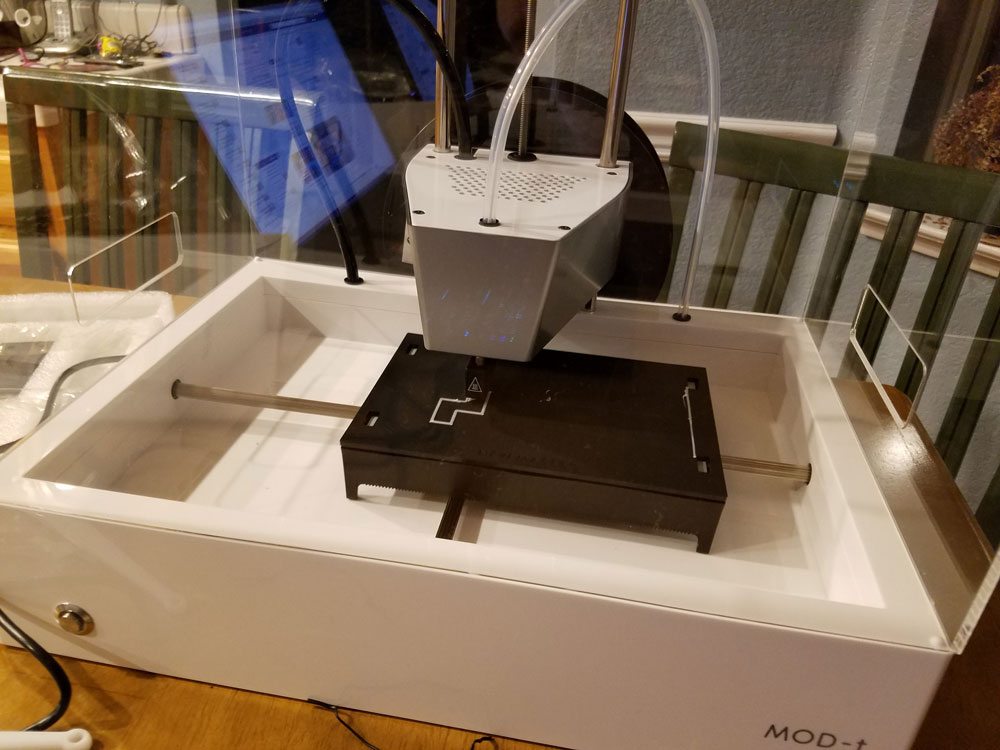
I’ve been curious about 3D printers since they first came on the market, but they’ve remained mostly out of my budget, and given my total lack of knowledge in 3D modeling, they seemed something of an extravagance. However, when New Matter offered to send me a review unit to test out, I was more than happy to jump at the chance.
The MOD-t, which they market as an entry-level, home 3D printer, came almost ready-to-use out of the box. I had to put together the build plate, which was only two pieces, load the filament,of course, and install a small program on my laptop that essentially connected the printer to my network, but then I was ready to go. A few reviews I read online said that the printer came with a small quantity of filament to get started, but, in fact, it shipped with a full half kilogram* of white filament, which seems like it’ll last quite some time. The printer also includes a set of tools to help maintain the unit.
The filament in question is non-proprietary PLA 1.75mm filament, so that’s more good news, as my local electronics store (Fry’s) had a huge variety of colors available. There are also a lot of options available on Amazon. The only things you have to pay attention to are that what you’re getting is PLA and that it’s 1.75mm. I have already picked up spools of yellow, gray, and glow-in-the-dark.

Printing is designed to be easy with the MOD-t, and indeed it is. The printer is set up to function over Wi-Fi, which is actually great because it can eventually live in the study, but I can send print jobs from the couch. The easy way to print is to log in to the New Matter website (the account is free) and control the printer from there. Using a very intuitive system, you can quickly load and unload filament and control print jobs. The site also has a library of ready-to-print models available, many for free. My first print was a simple cube puzzle. I selected it from the library, and about 30 minutes later it was in my hands so that I could start trying to figure out how to solve it.
While printing the items in the New Matter library is the easiest way to go, you can print from other sources as well by simply uploading a .STL file to your New Matter account, which I’m learning is a semi-standard 3D file format. A little time on Google revealed a wealth of websites with free-to-download STL files.

Of course, if you know how to model in 3D, you can use most commercially-available modeling software to create your own designs, export them as STL, and then you’re good to go.
Because I was curious and wanted to make the review as thorough as possible, I also explored the printer’s off-line mode. This requires that you plug the printer into your computer via an included USB cable. You also need some additional software to convert your model to g-code, which essentially defines the individual layers to the printer. I was able to use Cura, a free program, to do this. Once the model is in g-code, you can load it into the MOD-t’s application–the program you installed during setup–and send the job to the printer. I used this method to print the GeekDad meeple, which was kindly provided to me by fellow GeekDad Will James.

Printing is slow–the meeples took about 10 minutes each, while the BB-8 neckerchief slide took several hours. However, I have been told that all 3D printing is slow, but I don’t have a basis to use to compare print times.
One thing that is unique about the MOD-t is that, unlike other printers, the nozzle only moves up and down. The build plate does all of the horizontal movement. This certainly makes the printing more interesting to watch, although a couple of times I’ve discovered that it can cause models to tip over during printing. I had the BB-8 slide fail once while printing because of this. I can’t be certain that the tipping is due to the way things move in the printer, but it does seem likely.

The only kind of important downside I’ve discovered is that the piece that holds the spool of filament isn’t large enough to support the 1KG size. I was able to get it to work by simply laying the spool on its side, since it draws from the spool slowly enough that there isn’t much movement, but in the long term, I think I need to work out a solution. Fortunately, I now have a 3D printer, so I can fabricate a solution.
Overall, I’m very much enjoying the printer. At $399.99, it’s certainly one of the more affordable units on the market, and it does seem like a great way for families to start exploring the world of 3D printing and modeling. Both of my kids have expressed an interest in learning how to make things to print, which is great. It, of course, means that I need to learn how to do it myself, but that’s OK too.




This looks Awesome! I have been dying to get into this technology!